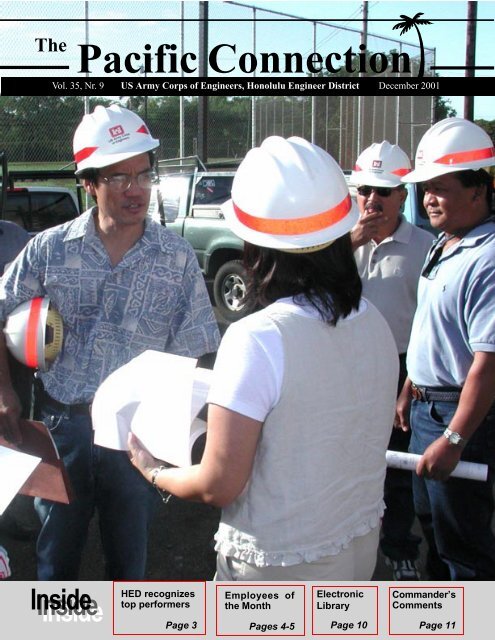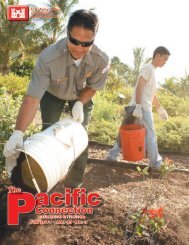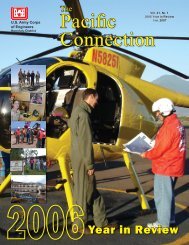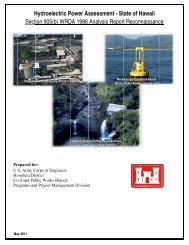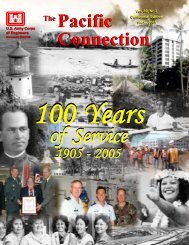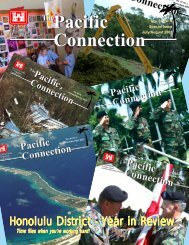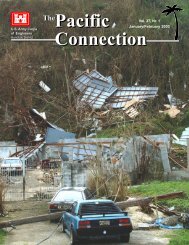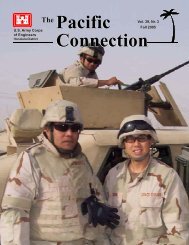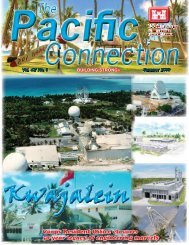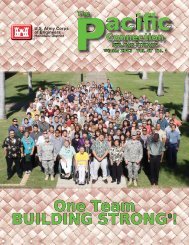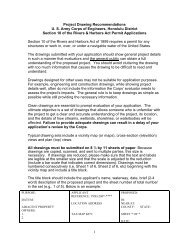Pacific Connection - Honolulu District - U.S. Army
Pacific Connection - Honolulu District - U.S. Army
Pacific Connection - Honolulu District - U.S. Army
You also want an ePaper? Increase the reach of your titles
YUMPU automatically turns print PDFs into web optimized ePapers that Google loves.
2 The <strong>Pacific</strong> <strong>Connection</strong> December 2001OpinionThe art ofcommunication:Thenand nowBy Maj. Scott SchrinerDeputy CommanderWhen I was younger, the rotary phone was the standard.You actually had to “dial” each number, meaning that your fingerfollowed it around the circle and speed never really was part ofthe equation because you waited for the dial to return to zeroafter each digit. You were considered lucky if you had a privateline. Our family had a party line. Neighbors could listen in onyour calls at will.Technology advanced and those of us out in the “sticks”were next afforded the opportunity to have a private line. Oh,what a blessing it was! No more guessing whether the phone callwas really for your residence or that it bled over from your partyline partners.Leap forward a few years and push button phones are in.No more “dialing.” It might even be more appropriate to sayyou’re going to punch someone’s number, but we don’t want toget into trouble do we? With modern telephones, you can evenflip a switch from pulse to tone depending on your telephonecompany’s equipment and services offered.Nowadays, things are changing again. An increasingmajority of communication services include cellular phones andare email-based. If I asked my nephew to describe a rotaryphone, I would probably get that dazed and confused looksuggesting that once again I was proving that I came fromanother planet. And, since I have indeed mastered the telephoneand am not fully satisfied with the shortcomings of email, hemight have something there.As many of you know, I am not a fan of using email forroutine communicating when a phone call or personal visit servesthe purpose much better. I particularly don’t like email when it isused as a method of leadership or counseling. It isn’t. I feel it issheer laziness. It is too easy to sit behind a desk and fire out 100On the cover: Gerald Young talks to new employees ata project site as part of a new HED initiative designedby Maj. Scott Schriner, Deputy Commander. The twodayoverview helps familiarize new employees to HEDby introducing them to all of the different divisionswithin the <strong>District</strong> so they can better understand howthey fit into the big picture. —Photo by Michelle Cain.The <strong>Pacific</strong> <strong>Connection</strong>, an unofficial publication authorized byAR360-1, is a monthly newspaper produced by the Public AffairsOffice, <strong>Pacific</strong> Ocean Division and <strong>Honolulu</strong> Engineer <strong>District</strong>, US<strong>Army</strong> Corps of Engineers, Fort Shafter, HI 96858-5440. Telephone(808) 438-9862. This command information newspaper is for employeesand others who request it in writing. Contents are notnecessarily the official views of, or endorsed by, the U.S.This newspaper is printed Government, the Department of Defense or the Department of theon recycled paper. <strong>Army</strong>. Circulation: approximately 1,300.emails within an hour telling people what they need to do andexpect immediate results. Also, the assumption is that once thesender sends the email, the receiver immediately reads it and actsupon it. Wrong assumption! Do you know what they had plannedfor today? Are they even in the office? Maybe they’re on leave?You can’t get this by sending out electrons alone. You get it onlythrough complete communications.Let me throw a few scenarios at you and you pick the rightanswer.1) Email is an effective way to send one liners back andforth between employees sitting less than 20 yards apart.a. True. b. False.2) It is great to attach as many names as possible on the cc:when you are chastising a fellow employee in order to humiliatethem in front of their peers, subordinates, superiors.a. True. b. False.3) Email is an ineffective way of communicating withmany people all around the world, sending files back and forth,when the USPS has been in business a lot longer and could useyour support.a. True. b. False.4) It is perfectly acceptable for a leader to use email toconduct quarterly counseling in order to avoid talking personallywith the employee.a. True. b. False.If you answered false to all of the above, I am glad to haveyou on my team. If you thought that some of the answersdeserved a true response, I’d like to see you reevaluate thesituation. Another of my pet peeves is the misuse of the “replyall” from a “Dist A” message. There are valid reasons to use the“Dist A” option. I have used it a few times when speed is of theessence when gathering information. The voting button optionalso is great. It provides an extremely fast way of gathering andtabulating data. What irks me is the use of reply all from a “DistA” message. If you have a problem, concern, issue, contact thesender directly (via office visit or phone call). Don’t waste otherfellow employees’ time making them read your rebuttal. Onefinal note here, USE SPELL CHECK!Okay, so I have been bashing email. Like any tool, it can bemisused. There is a good side to email. We can reach out worldwide,day or night, to contact a colleague at the far reaches of theglobe without having to match time zones when trying to callthem. Just send a message and wait for their reply. It is also greatto send files back and forth. It sure beats waiting for the postalsystem to deliver the mail, especially in these difficult times ofincreased security.Remember, one of Lt. Gen. Flowers’ three strategic goals iscommunication. Also, Brig. Gen. Johnson is interested in it aswell. He paid us a visit on November 19 and asked for our helpwith internal communications. Reading between the lines, whichwasn’t hard, we need to lead people through personal communications,not by conducting artificial counseling hiding behindemail.<strong>Honolulu</strong> Engineer <strong>District</strong> Commander.........................Lt. Col. Ronald N. LightChief, Public Affairs ...............................................................Douglas S. MaKittenPublic Affairs Specialist.................................................................Alexander KufelEditor ..................................................................................................Michelle Cain
December 2001 The <strong>Pacific</strong> <strong>Connection</strong> 3HED recognizes top performersBy Doug MaKitten<strong>Honolulu</strong> Engineer <strong>District</strong> recognizedits top performers in a Dec. 7ceremony at Fort Shafter that introduced anew awards program to the <strong>District</strong>.The <strong>District</strong>’s Tripler <strong>Army</strong> MedicalCenter Project Delivery Team earned the HuiO’i Loa (Hawaiian for being the best team)award for its outstanding work on the Triplerlaser eye surgery and vascular laboratoryprojects.Team members include the projectmanager Randall Kurashige, Jody Muraoka,Michael Onuma, James Pak, Dixon Park,Brad Scully, Allyn Tabata, Aaron Tashiro,Linda Tsugawa and Richard Yoshimura.Raymond Kishaba received the“Alaka’i (one with personal strength whoexhibits leadership quality) award as the<strong>District</strong>’s project manager of the year.Raymond Kong received the Maika’iLoa (mighty, achieving excellence) as the<strong>District</strong>’s leader of the year.Three employees received Ikaika Loa(power of knowledge, professional skills andexpertise) awards.HED’s Tripler <strong>Army</strong> Medical Center Project Delivery Team members are therecipients of the Hui O’i Loa award for their work on the TAMC laser eyesurgery and vascular laboratory projects. The award is one of several presentedas part of the HED’s new awards program. —Photo by Michelle CainJeannette Anderson was named AdministrativeEmployee of the Year.Ernesto Guerrero was named TechnicalEmployee of the Year.Olson Okada was named ProfessionalEmployee of the Year.David Okada, HEDDesign Branch civilengineer, does apreliminary damageassessment of thePago Bay Bridgewith representativesof the GuamWaterworksAgency. The bridgesustained damageto a water main duringan earthquakethat struck the islandon October 13.—Photo by DonYorimoto.Perspective:A child on a farm sees a plane fly by overhead and dreams of a faraway place. A traveler onthe plane sees the farmhouse and dreams of home. —CarCarl l Burnsns
4 The <strong>Pacific</strong> <strong>Connection</strong> December 2001Employees of the MonthJesse DuarteHometown: Corpus Christi, TexasFamily: Wife, DarlenePosition with Corps and how long: Civil engineer for 13monthsDescribe your job in 50 words or less: My job as theConstruction Services Branch Chief, in a nutshell, is tokeep the projects moving as smoothly as possible administratively,and to assist where appropriate with civil/technicial issues.What do you like best about your job? Part of thesatisfaction comes from resolving problems which otherwisewould impact contract schedules, dissatisfy thecustomer, or add cost to the project. There’s also adistinct sense of accomplishment in seeing a project tofruition.What is the most difficult part of your job? Balancingtime against customer/contractor demands.If I was the DE for a day, I would... consider buying abig morale booster like a jetski, motorboat, or other craftfor occasional island hops. (I know... wishful thinking!)What is the best improvement in the <strong>District</strong> in the pastsix months? I suppose that for the <strong>District</strong> that would bethe office furniture.What is the best improvement in your office in the pastsix months? The addition of my wife to our team (I’ve justearned brownie points!), and our new server.Randall KurashigeHometown: <strong>Honolulu</strong>, HawaiiFamily: Wife, Rae and daughters, Lauren (13) andJodi (4)Position with Corps and how long: Project manager inPrograms and Project Management Division. Twentyyears of federal service, all with the Corps.Describe your job in 50 words or less: I get projectsdesigned and constructed. I need to ensure that the expectationsof my customers are met or exceeded so that theyare satisfied. I do this by trying to ensure quality, controlcosts, and stay on schedule.What do you like best about your job? The opportunityto work with people. I have had a chance to work with verygood folks in this job. I have benefitted greatly from thisinteraction.What is the most difficult part of your job? Havingenough time to accomplish all the things I want to get doneand still have time for family.If I was the DE for a day, I would... I don’t know if I woulddo anything differently.What is the best improvement in the <strong>District</strong> in thepast six months? Furniture is the most visible improvement.It seems a lot of effort has been put into improvingthe workplace.What is the best improvement in your office in the pastsix months? We’ve gotten a lot of new folks on board, andwe all have nice places to work in, too.Challenges:Challenges are what make life interesting. Overcoming them is what makes life meaningful. —Joshua Marine
6The <strong>Pacific</strong> <strong>Connection</strong>December 2001“The stockings werehung in Office ofCounsel with care...”—Photo by MichelleCainHED celebratesthe holidaysAbove right: ShirleyKoga and DonnaKanetake, OC, wrappackages to giveaway. OC, with helpfrom CT, adopted afamily in need thisChristmas. At right:Clifford Olivera, LM,accepts the first-placeaward from ClarenceWilhelm, Fort ShafterChristmas card committeedirector. Oliveraspent many hours ofhis own time creatingHED’s entry. —Photosby Michelle CainWorords:Many wise words are spoken in jest, but they don’t compare with the number of stupid words spoken in earnest.—Sam Levenson
The <strong>Pacific</strong> <strong>Connection</strong>7Holiday greetings fromthe Chief of EngineersThe holiday season is traditionally a time to pause and reflect on thepast year, and the challenges of the coming year. I’m sure you will all agree thatthis past year has given us a lot to think about. And we have much to be thankfulfor, both as an organization and as individuals.I am personally thankful that no Corps employees were lost during theterrible attacks on Sept. 11. And I am thankful to have the opportunity to leadour great organization with some of the finest people in the U.S. government.You all proved that this past year, and I am very proud of you.Although the terrorist attacks are foremost in our minds, they were not theonly emergency operations we faced in 2001. After an ice storm in Oklahoma lastChristmas, our employees cleaned up tree debris at their projects, often workingwithout electricity, phones, or water. Additionally, Tulsa <strong>District</strong> delivered250,000 gallons of water to stricken counties.Seattle <strong>District</strong> rode out a magnitude 6.8 earthquake, then went into immediateaction in support of the ederal Emergency Management Agency (EMA),and to assess the integrity of Corps projects in the area.We took part in a flood-fight last spring in the upper Midwest. We distributed 3.2million sandbags to local communities, and Corps emergency work (mostly levee building)prevented more than $50 million in damage to North Dakota and Minnesota cities.Corps personnel responded to Tropical Storm Allison. They supplied emergencypower, temporary housing, debris removal and monitoring, distributed 100,000sandbags, and provided utility hook-ups for 950 temporary housing trailers.All that, plus our normal work-load — supporting <strong>Army</strong> Transformation,environmental restoration at military and civil works sites, research and development,building housing and other facilities for the Air orce and <strong>Army</strong>, civil worksprojects throughout the country, and support for others, just to name a few.But the terrorist attacks on the World Trade Center and the Pentagon havedominated our thinking and emotions. I’m enormously proud of the work wedid on Sept. 11 and the days following.At both the World Trade Center and the Pentagon, we had people on the groundin less than two hours assessing the situation and lending assistance. We had literallythousands of volunteers to help in New York, and the city welcomed the work they didthrough EMA – structural response, temporary power, debris removal, and more.The Corps’ response to the terrorist attacks was tremendous, and I couldn’t bemore proud of you all. But work that intense takes a lot out of you, plus the uncertaintiesof the war against terrorism and what the future holds adds additional strain.I would appreciate it if everyone would take extra care of each other in thecoming year. There is no one better able to assess how people are feeling thanthose around them. Look each other in the eye now and then and earnestly ask,“How’s it going?” Then listen and help each other.Our entire country seems to be drawing closer together and reaching out tohelp others, a little more aware of what’s important in life, and of our need foreach other. If we in the Corps of Engineers continue to be thankful for ourblessings, and keep reaching out to one another, we will be more than ready totackle the challenges that next year will bring.My family joins me in wishing you a safe and joyous holiday season, anda happy, exciting New Year. Take some well-deserved time off, relax, and enjoybeing with your family and friends.Essayons!ROBERT B. FLOWERSLieutenant General, USACommandingCourage:Above: Pauline Kahalioumi, IM, and Rolando Castillo, LM, unloada truck-load of toys, clothing, and household items at theCommunity Clearinghouse. HED employees donated two pickuptrucks full of items, including 689 pounds of food that wasdropped off at the Hawaii Food Bank. —Photo by Michelle CainHEDcelebrates theholidaysThey may be trying to disguise themselves, but we know ourleaders when we see them! Maj. Scott Schriner, DDE, Ray Jyo, PP,Lt. Col. Ronald Light, DE, and Sam Song, EC, enjoy a game at theSEPC Christmas party. —Photo by Donna KanetakePain nourishes courage. You can’t be brave if you’ve only had wonderful things happen to you.—Mary Tyler Moore
8 The <strong>Pacific</strong> <strong>Connection</strong> December 2001Spotlight on HEDEngineering andConstruction DivisionSpotlighting an office that is helping to make the <strong>Honolulu</strong> Engineer <strong>District</strong>“The Best Place for the Best People to Work.”Interview and photoby Michelle CainThis month I talked with JimBersson, HED’s Chief of Engineeringand Construction, to find outhow his organization contributes to theoverall mission of the <strong>District</strong>.<strong>Pacific</strong> <strong>Connection</strong> (PC): What is E&C?Jim Bersson (JB): Engineering andConstruction Division (E&C) is the largestdivision in HED, comprised of approximately230 engineers, architects, scientists,technicians, and administrativepersonnel. We are divided into sevenbranches: Design; Cost Engineering; CivilWorks Technical; Engineering Services;Environmental Technical; Regulatory; andConstruction, which is our largest branchand includes four resident offices. Theyare located at Ft. Shafter, SchofieldBarracks, Kwajalein, and Palau.PC: What are some of the responsibilitiesthat fall under the E&C umbrella?JB: E&C’s responsibilities are many anddiverse. They include virtually all theservices the <strong>District</strong> provides its customers.To put it another way, E&C providesservices necessary to plan, design,construct, and (in some cases) maintainmilitary, civil works, environmental, andsupport of other agency projects throughoutthe <strong>Pacific</strong> region. E&C also providesengineering services for other PODdistricts, operates a Regional Visitor’sCenter at Ft. DeRussy, and administers theDepartment of the <strong>Army</strong> (DA) RegulatoryProgram in Hawaii and U.S. possessionsin the <strong>Pacific</strong>.Humor:PC: What is the DA Regulatory Program?JB: Department of the <strong>Army</strong> permits arerequired for all construction and dredgingin navigable waters of the United States;for projects discharging fill into jurisdictionalwaters of the United States, includingwetlands; and for transportation ofdredged material for the purpose of oceandisposal. The program is unlike anything“ First and foremost ismaintaining the capabilityto provide superiorservices to our customers.”— Jim Berssonelse we do in that we are acting in aregulatory capacity, as opposed to as aproject proponent. It is also highly visibleto the public and can be quite controversial.PC: Who does E&C deal with outside ofHED?JB: E&C deals with many organizationsand entities outside of HED. Theseinclude: customers, local and foreigngovernment officials, the general public,architect-engineer firms, constructioncontractors, the media, <strong>Pacific</strong> OceanDivision(POD) and other POD districts,and USACE Headquarters, laboratories,and centers of expertise such as theProtective Design Center in Omaha. E&Calso maintains close ties with localindustry organizations to include theAmerican Institute of Architects, theConsulting Engineers Council of Hawaii,the General Contractors Association, theBuilding Industry Association, theAssociated Builders and Contractors, andothers. We hold an annual workshop withthese organizations where we provideinformation and exchange ideas.PC: What engineering services doesE&C provide other POD districts?JB: In the past year we provided design,technical review, cost engineering, claimssupport, contract negotiations, andenvironmental support services to theother POD districts. HED has beendesignated a regional technical reviewcenter within POD, which the otherdistricts use to augment their own capabilitiesin this area.PC: What is E&C’s role in the ProjectManagement Businesss Process(PMBP)?JB: E&C folks perform technical servicesand form the bulk of project deliveryteams, or PDT’s. Most of our PDT’sinclude environmental specialists, costengineers, designers, design reviewers,negotiators, and construction managers.These and other PDT members are criticalto the success of our projects. In somecases, E&C folks serve as the projectmanager in addition to their technical role,particularly for projects with a narrowscope, such as an environmental study.PC: How do you ensure that everyone inyour division is trained and current intheir professional qualifications?JB: Obtaining professional registration forfolks in job series such as engineering orarchitecture is highly encouraged. ThereHumor: The most wasted of all days is that on which one has not laughed. —Nicholas-Sebastian Chamfort
December 2001 The <strong>Pacific</strong> <strong>Connection</strong> 9has been an increased emphasis on this inUSACE. Some positions require registrationas a prerequisite for selection.Everyone is required to maintain anindividual development plan which isgeared toward accomplishing the missionrequirements of each branch in E&C.Supervisors and employees reviewtraining needs annually and programneeded training. They also take advantageof unscheduled training that is relevant tomission areas. An example of the latter isunscheduled training we sent key peopleto in anti-terrorism/force protection, whichhas received increased emphasis in theaftermath of September 11th. We also holdmonthly technical seminars for our folks.PC: What role do the field offices playin accomplishing the E&C mission?JB: Our construction resident offices arekey to the accomplishment of not just theE&C mission, but the <strong>District</strong>’s mission asa whole. The resident office folks administerand manage construction projects,negotiate modifications, and ensure theprojects are constructed in accordancewith the contract documents. As ourrepresentatives at installations and projectlocations, they have frequent contact withcustomers and perform a myriad ofcooordination activities to facilitateconstruction. An example occurred duringthe high threatcon levels in the aftermathof September 11th, when our folks spentcountless hours assisting contractors gainaccess to military installations, thusminimizing delays to projects. Our projectengineers are also responsible for ensuringthat contractors adhere to the safetyrequirements in their contracts.We also maintain a small regulatoryfield office in Guam. Its primary missionis to administer the DA regulatoryprogram in Guam and the CNMI, but theoffice also acts as the <strong>District</strong>’s forwardpresence in that part of the world andassists the <strong>District</strong> Headquarters in anumber of ways, such as by facilitatingcontact with local governmnent officials.PC: What are some of the challengesthat face E&C?JB: First and foremost is maintaining thecapability to provide superior services toour customers. Continuing to do this willrequire us to shape the workforce toPararenting:accomplish our current and futuremissions. This is critical in view of theincreases we foresee in our program, interms of both dollars and missions; andour mature workforce. Many of our peoplewill be eligible for retirement in the nextseveral years. We want to make sure wehave sufficient numbers of trained folks toreplace them and capture the benefits oftheir knowledge and experience. To thatend, we have been hiring. We filled 39positions since Oct. 1, 2000 and arecurrently recruiting for 10 additionalpositions. E&C also has the lead on aFY02 OPLAN initiative to develop acomprehensive human resource plan forthe <strong>District</strong>, which will focus on this issuefor the long and near term.Another challenge is to continue toleverage technology. We rely heavily onautomation, such as Computer AssistedDrawing and Design (CADD) andDrChecks (an automated design reviewand lessons learned system), to increaseour productivity and accomplish our work.We need to continue to stay abreast oftechnological advances and ensure arepeople are trained. We are implementing aTechnology Integration Group withinE&C to help us do that.Improving our business process is acontinuing challenge. The <strong>District</strong> hascome a long way with implementation ofthe PMBP; we are now involved in theISO 9001 implementation process, whichis being lead by PPM. E&C is leading ateam working on a FY02 OPLAN initiativerelating to our business process - howto improve our small and routine projectexecution. It is difficult for an organizationthat manages projects in the $100 millionrange to be efficient managing projectsunder $100 thousand. The team willaddress how we can better achieve that.There are also potential challengesover which we have minimal or nocontrol, such as mandates requiringincreased use of design-build contractingand privatization. For those, all we can dois stay informed, participate in thedialogue, and adjust our plans andprocedures accordingly.PC: Do you have any final comments?JB: E&C is involved in just abouteverything the <strong>District</strong> does, but we don’tdo it alone. We’re part of a team - manyteams, in fact. It would take a lot moretime to go into much detail on the wonderfulthings the individual branches do but Iwould like to close by saying that ourbiggest asset is our people. They arededicated and extremely capable. Theservice they provide to our customers andto the nation is invaluable.Lolly Silva, regulatory branch, takes soil samples to determine if this possiblewetland falls within HED’s jurisdiction.Good parents give their children roots and wings. Roots to know where home is, wings to fly awayenting:and exercise what’s been taught them. —Jonas Salk
10 The <strong>Pacific</strong> <strong>Connection</strong> December 2001Electronic Libraryby Ruby MizueCONSTRUCTION CRITERIA BASE (CCB) UPDATEFor those of you who use CCB on the network, the newedition #58 has replaced the current DVD. Instructions forupdating as well as new installations are posted in the POHPublic Folders, Information Management Folder, Elibrary<strong>Connection</strong> box.Beginning in 2002, CCB disc sets will be published twice ayear, in April and October, instead of the current quarterlyschedule. This is the final regular quarterly edition of CCB. Wewill continue to have password access to CCB On-Line (Internet)for at least one year, with even more emphasis placed on thecurrency and completeness of documents and programs availableon the CCB website.The change will enable subscribers to take advantage ofCCB On-Line for timely updating and easy access to guidespecifications and other documents which are quickly updated onthe website. Alternatively, the option of CCB on CD-ROM orDVD will continue to be the choice for very large documents(which often take impractically long to download with normalinternet connections), and for proprietary documents such ascodes and reference standards which cannot be distributed on theInternet.Visit CCB Online at: < http://www.ccb.org/> for generalinformation about the electronic collection of over 10,000documents used in building design and construction. Call RubyMizue at 438-8348 if you need a username/password or assistancein using the resource.Request for Leave and Approved Absence FormIf you are still using the old familiar SF71 to submit leaverequests, you are using an obsolete form! It has been replaced byOPM Form 71, same title, which can be filled out electronicallyin Formflow at: S:\forms\formflow\OPM0071.frz. Besure you save your DATA on a diskette or your hard drive—DoNOT save your personal data on the S:\ drive!INTERNET/INTRANET UPDATETwo Commander’s Policy Memos Posted at http://www.pod.usace.army.mil/info/hedcom.htmlCommander’s Policy Memo #7, After Action ReviewStandards and Procedures, has been revised. The revisionadjusts thresholds for informal and formal AARs, provides amatrix outlining all requirements on one page, provides thestandard <strong>Army</strong> memo format as the format to record AARs, andadds design completion and construction completion customersurveys to the AAR process.A new policy on Designation of Mission EssentialPersonnel During Times of Crisis has been posted asCommander’s Policy Memo #14. This policy prescribeswhich employees are considered mission essential in order tokeep HED functional and mission ready at all times. It alsoestablishes a telephone roster notification/message system.PMBP Standing Operating Procedures (SOP) RevisedThe series of SOPs developed in support of <strong>Honolulu</strong><strong>District</strong>’s Project Management Business Process (PMBP) wasfirst posted in June 2001. These SOPs have been revised andare now posted on the Intranet page at https://pohinfo/SOP/SOPindex.html.New AARs, customer feedback, and information papersare posted continually throughout the year. Be sure to useIntenet Explorer to access the POH Intranet at https://pohinfo.Brig. Gen. Ronald Johnson, CommandingGeneral, <strong>Pacific</strong> OceanDivision, paid a visit to the <strong>District</strong>on Nov. 19-20. Johnson touredHED offices and visited projectsites during the visit. Here, he receivesa briefing at Tripler <strong>Army</strong>Medical Center from RobertMorishige, project engineer, on replacingair handling units atTAMC. Pictured from left are MartinLau, TAMC’s Chief, FacilitiesManagement Branch, Johnson,Col. Terry Youngbluth, PODdeputy commander/Chief of Staff,and Morishige. —Photo byMichelle CainAge:The man who views the world at 50 the same as he did at 20 has wasted 30 years of his life. —Muhammad Ali
December 2001 The <strong>Pacific</strong> <strong>Connection</strong> 11Commander’s Comments“ No one else providesthe breadth anddepth of services the<strong>District</strong> delivers.Change:”By Lt. Col.Ronald N. LightHED CommanderAmerica’sengineers inthe <strong>Pacific</strong>At our recent Town Hall meeting, I presented a number ofyou with our <strong>District</strong> Coin. If you look, you’ll see that the coincontains the phrase “America’s Engineers in the <strong>Pacific</strong>.” This is apowerful notion, and I want to share with you my perspective onwhat it means.During World War II, the <strong>Honolulu</strong> Engineer <strong>District</strong> employedsome 26,000 people! While we are much smaller today, ata staff of about 400, we still serve mightily. No one else in the<strong>Pacific</strong> provides the breadth and depth of services we deliver.When I think of our service in the <strong>Pacific</strong>, many things cometo mind. I think of the Palau Compact Road Resident Office staff,nearly 5,000 miles away, building a 53-mile road through the Republicof Palau, one of the world’s newest independent countries.Most people I speak with outside of the <strong>District</strong> have never heardof the Republic of Palau, yet we have a dedicated staff of professionalsthere working selflessly. Led by Alex Morrison, our PalauCompact Road Resident Office helps ensure the economic vitalityof the <strong>Pacific</strong> region.Our small staff of two people in Guam likewise comes tomind. Frank Dayton and Carolyn Holliday manage our regulatoryprogram, and provide continuity and assistance in our civil worksmission on Guam. You may never meet Frank or Carolyn, but letme assure you that they represent the <strong>Honolulu</strong> Engineer <strong>District</strong>and the US <strong>Army</strong> Corps of Engineers well, and are well known inboth Guam and the Commonwealth of the Northern Mariana Islands(CNMI). Frank and Carolyn are helping to preserve and protectthe environment of the <strong>Pacific</strong> region.Although Joe Mau, Frank Ono, and Charles Adams don’t livein Saipan, CNMI, they might as well. Together these three men (thefirst two from the Fort Shafter Resident Office, the third from PPM)have spent hundreds of hours in the small village of Tanapag ensuringthat PCB-contaminated soil is remediated. They’ve withstoodtyphoons, some fierce public opinion, and life in a hotel room forweeks on end. These men, and those who came before them, servewillingly far from home: they, too, are America’s Engineers in the<strong>Pacific</strong>.Closer to the Hawaiian Islands, the men and women of theKwajalein Resident Office continue a tradition of service and sacrificeof more than 42 years. Part of the Republic of the MarshallIslands, Kwajalein is home to the US <strong>Army</strong> Kwajalein Atoll(USAKA) and the Ronald Reagan Missile Test Facility. The workthat Lou Askew and his staff perform for USAKA and others onKwajalein sometimes goes unnoticed. But Lou and his staff are onthe cutting edge of our country’s missile defense program, and theyare helping to protect as well as build the <strong>Pacific</strong>.Further south, across the equator, Stan Boc, Milton Yoshimoto,and Al Cambra have a reputation for service in American Samoa.The small boat harbors, roads, and shore protection projects the<strong>District</strong> has built during the past 20 years in American Samoa arevital! These projects, like much of the other work we do in the<strong>Pacific</strong>, bring jobs, commerce, access to medical care, and pave theway for other needed infrastructure. Truly, Stan, Milton, and Al cancount themselves among “America’s Engineers in the <strong>Pacific</strong>.”Elsewhere, throughout the region, Zandra Smith, of our RealEstate Division, manages dozens of military recruiting facilities forthe <strong>Army</strong>, Air Force, Navy and Marines. Zandra’s efforts help buildthe <strong>Pacific</strong> by providing opportunities for <strong>Pacific</strong> Islanders to servein our Nation’s armed forces. They infuse in our military a diversityand appreciation for the <strong>Pacific</strong> region which is unmatched! Inher way, Zandra is building the <strong>Pacific</strong>, too.Finally, here in Hawaii the rest of the <strong>District</strong> serves to buildthe <strong>Pacific</strong>. With environmental services oversight performed byBeth Miura at Makua Military Range and the Pohakuloa TrainingArea. With whole barracks renewal at Schofield Barracks performedby a host of construction reps, project engineers and others servingin the Schofield Barracks Resident Office. (These same people areon the leading edge of bringing <strong>Army</strong> Transformation to the 25 thInfantry Division, an enormous effort of strategic importance toour <strong>Army</strong> and our nation.) With aircraft hangar and pavement renovationby Bob Inouye and Ed Yago, and others in the Fort ShafterResident Office. With constant, around the clock work at the Tripler<strong>Army</strong> Medical Center, at the capable hands of Randy Kurashige,Olson Okada, and Bob Morishige, to name only a few.Of course, behind every successful project is a project deliveryteam of designers, resource managers, contracting specialists,logisticians and other support staff, making it all happen. I want toacknowledge the hundreds of people in the <strong>District</strong> who work dayafter day, professionally completing every task they undertake. Someof these people shy away from the spotlight, and work diligentlyeach day; they deserve our respect, thanks, and admiration as well!Every one of you is part of the <strong>Honolulu</strong> Engineer <strong>District</strong>’smission to build the <strong>Pacific</strong> region. Thank you again for your service,professionalism, and dedication. You are part of the economicvitality of the region. And indeed, you are “America’s Engineers inthe <strong>Pacific</strong>!”It has the power to uplift, to heal, to stimulate, surprise, open new doors, bring fresh experience andChange: create excitement in life. Certainly it is worth the risk. —Leo Buscaglia
12 The <strong>Pacific</strong> <strong>Connection</strong> December 2001HED<strong>District</strong>ShortsAloha means hello toStuart Fermahin, SBRO. Alohameans hello to JeffHoneycutt, Palau ResidentOffice. Aloha means helloto Janice Brissette, newChief, Resource Management.Aloha means hello toEmily Fu and Felicitas Basa, RM. Aloha meanshello to Darrin Berends, engineer at KRO. Aloha meanshello to Christi Shaw and David Grant, archeologists in theEnvironmental Technical Branch. Aloha means hello toHarmon Slappy, Ordinance and Explosive Waste Specialist inthe Environmental Technical Branch. Aloha means goodbyeto Sharon Sherry, IM, who has retired after 37 years withthe Corps of Engineers. Aloha means good-bye to EstherCruz, RE, who has transferred to AED. Aloha means goodbyeto Nellie Arnold, RM, who has accepted a position with theNavy at CINCPAC, Camp Smith. Aloha means good-bye toAnita Alcantara, RM, who has transferred to JED. Alohameans good-bye to Lyle Otineru, Civil Works TechnicalBranch, Regional Visitors Center, who has accepted a positionwith the Directorate of Plans, Training and Mobility. Congratulationsto Lynn Arakaki on her promotion to Chief ofConstruction/A-E Contracts. Congratulations to DanNakamura on his promotion to Chief, Environmental TechnicalBranch. Congratulations to Olson Okada on his promotionto senior project manager at TAMC. Congratulations toGlen Takishita on his promotion to senior project manager forfamily housing and non-appropriated funds projects. Congratulationsto Earl Hiraki, whose position as SBROResident Engineer has been upgraded. Congratulations tothe following employees who received awards at the Town Hallmeeting Dec. 7: Suggestion Program awards for suggestionsresulting in more than $112,000 in verified saving and morethan $51,000 in unverified savings to the <strong>District</strong>: MariaBuckner, Joy Sakamoto, Jeanette Anderson, ElaineNagasawa, Hiroaki Morita, Kent Tamai, and Rick Oleniaczreceived on-the-spot cash awards; Amy Izawa, CharleneHasegawa, Lynette Serrao, Amy Loo, Sandy Ginto, JimCainelli, Vince Faggioli, David Kam, and Debbie Alexanderreceived HED briefcases. Special Emphasis ProgramCommittee members for their contributions to the <strong>District</strong>:Linda Hihara-Endo, Renee Hicks, Sharon Ishikawa, PaulineKahalioumi, Alexander Kufel, Donna Kanetake, KurtisKikkawa, Gary Kitkowski, Randall Kurashige, David Lau,Tammy Luke, Maydean Martin, Kent Tamai, Wendy Mow,Dan Nakamura, Vecy Pascual, Lolly Silva, Anna Tarrant, EdYoshimura, and Jeannette Anderson received HED briefcases.Commander’s coins in recognition of the employee’sprofessionalism, dedication to duty and commitment to theexecution of HED’s missions and the <strong>District</strong>’s Operations Plan:Barbara Mills, Paulette Choy, Austin Rester, Polly Bjorken,Shane Brady, Michelle Cain, Rick Oleniacz, Joel Hendrix,Cyndee Oleyte, Katie Tamashiro, Ronnie Kirkland, AllenToma, James Pak, Tammy Luke, Pat Billington, Robyn Au,Donna Kanetake, Kenneth Santiago, M. Kalani Smith,Laureen Vizcarra, Sharon Kashiwabara, Dorinda Won,Rosaline Yagi, Charles Adams, Dean Fukuchi, and DarleneShimamura. No Ka Oi coin: Renee Kurashige for her workon the 2001 Combined Federal Campaign. Condolences toKurtis Kikkawa, CEPOD-CT, on the Nov. 12 passing of hisfather, Richard Katsunori Kikkawa, a retired estimator for theU.S. <strong>Army</strong> Corps of Engineers.Historical HED: A step back in timeOne year ago...Raleigh Sakado, deputy chief of HED Programsand Project Management, retired after 40 years of federalservice. He served 20 years active-duty militaryas an engineer, followed by 20 years of civilian servicewith the <strong>Army</strong> Corps of Engineers.Scott Newitt, POD Resource Management chief,retired after 41 years of federal service.Families at Schofield Barracks continue to moveinto newly-completed family housing units. HED supervisedconstruction of the $13 million project, builtby Hunt Building Corporation.ive years ago...A December 12 ceremony marked the comple-tion of a 30,000-square-foot addition and renovationof the 15th Air Base Wing medical and dental clinic atHickam Air Force Base. The $16 million project wassupervised by HED.Ten years ago...POD sent a five-member team to storm-damagedAmerican Samoa to support the Federal EmergencyManagement Agency’s relief action in the wake of tropicalcyclone Val.Construction began on the new <strong>Army</strong> ContinuingEducation System facility at Schofield Barracks. HEDawarded the nearly $8 million project to Tower ConstructionCo. of <strong>Honolulu</strong>.Imagination:Imagination is more important than knowledge, for knowledge is limited while imaginationembraces the entire world. —Albert t Einstein


